By Christina Mitchell
Labor Day is more than just the last gasp of summer
Hard as it is to believe, summer is nearly gone, and with it, a bumper crop of hefty tomatoes and soft, ripe fruits whose juices dribble down the chin. Toes in the sands of the Jersey Shore. Ears of corn as sweet as nectar.
If you’re a student, it’s about time to read less for pleasure than academics. If you’re a teacher, it’s time to prepare for fall classes.
The last hurrah, as we all know, is Labor Day, the first Monday in September, celebrated this year on the 4th. It’s the last three-day vacation until Columbus Day weekend in October and one of the last bursts of hot weather that give way to Indian summer.
But what is the true meaning of Labor Day? What should we be celebrating on that day? And how did it come about?
The answer to the last one, according to the U.S. Department of Labor, is that Oregon was the first state to pass a law recognizing Labor Day in 1887. Among its first celebrations was in New York City on Sept. 5, 1882, and Congress made it a national holiday for workers in 1894.
“The holiday is rooted in the late 19th century,” says the Department of Labor website, “when labor activists pushed for a federal holiday to recognize the many contributions workers made to America’s strength, prosperity, and well-being.”
Credit for the holiday has often been in dispute. But it’s generally agreed that Matthew Maguire – secretary of Local 344 of the International Association of Machinists in Paterson – proposed the holiday while serving as secretary of the Central Labor Union in New York, notes the website.
According to the New Jersey Historical Society, after President Grover Cleveland signed the law creating a national Labor Day, the “Paterson Morning Call” newspaper published an opinion piece stating that credit should go to Matthew Maguire, rather than the unrelated Peter J. McGuire, a carpenter’s union official and a co-founder of the American Federation of Labor.
(That union would eventually merge with the Congress of Industrial Organizations to become the mighty AFL-CIO).
The true meaning of Labor Day is in its rich history. It began at the end of the 19th century – the height of the U.S. Industrial Revolution – whose downside was 12-hour days and seven-day weeks in abysmal and often unsafe working conditions that earned many Americans only a meager living. And it was all too common for children as young as 5 or 6 to work in dangerous conditions so they could be paid far less than adults, according to the History Channel.
A not-entirely peaceful campaign by unions during those times gained strength and continued into the 1920 and ‘30s, and while union membership is lower than at its height in the mid-1950s, it helped raise the American standard of living – and working – considerably.
Membership over the last half century has fallen from 35% of workers in the private sector to about 6.5% today, according to the news site The Conversation. But it’s the labor of all workers – union or not – that has made America the greatest economic power in the world.
That’s the best reason we can think of to celebrate Labor Day.

